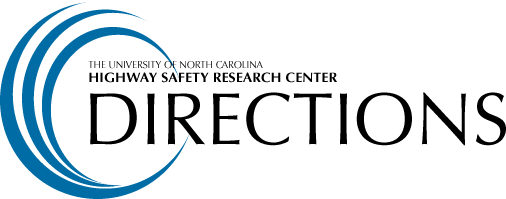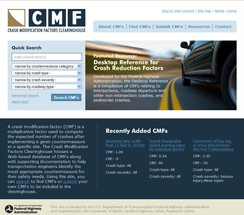

New Clearinghouse helps transportation professionals select road safety improvements

CMF clearinghouse Homepage
Transportation professionals now have a new resource to help them identify, implement and evaluate cost-effective roadway safety improvements. The UNC Highway Safety Research Center (HSRC), with funding from the U.S. Department of Transportation Federal Highway Administration, has established the Crash Modification Factors (CMF) Clearinghouse, a central, Web-based repository of Crash Modification Factors, or CMFs. The CMF Clearinghouse is located at www.CMFClearinghouse.org.
A CMF is an estimate of the change in crashes expected after implementation of a certain roadway safety treatment, such as a traffic signal. For example, imagine that an intersection is experiencing 100 angle crashes and 500 rear-end crashes per year. If you apply a countermeasure that has a CMF of 0.80 for angle crashes, then you can expect to see 80 angle crashes per year following the implementation of the countermeasure (100 x 0.80 = 80). If the same countermeasure also has a CMF of 1.10 for rear-end crashes, then you would also expect to also see 550 rear-end crashes per year following the countermeasure (500 x 1.10 = 550).
CMFs are often used by transportation professionals in their decision-making process to determine which countermeasures to implement in order to achieve specific safety gains. Previously, CMFs were located through various national and state sources. The CMF Clearinghouse gives transportation professionals' access to more than 1800 CMFs for over 400 countermeasures in one central, searchable location.
"Our goal is to provide practitioners with the information they need to make informed decisions for their road safety treatments," said Daniel Carter, engineering research associate at HSRC and member of the CMF Clearinghouse project team. "The CMF Clearinghouse brings together CMFs from references such as the Highway Safety Manual and the FHWA Desktop Reference Guide, as well as a multitude of recently published safety studies.”
By searching the CMF database, professionals can identify potential countermeasures, obtain their expected effectiveness, compare alternative treatments and find resources on cost-benefit analysis. This enables users to make educated decisions about the most applicable CMF to their condition. In addition to the vast listing of CMFs, the Web site includes a general overview of CMFs, a glossary of terms related to CMFs and a listing of frequently asked questions. Users may access a comprehensive resources section that includes links to CMF-related information on trainings, resources and publications.
The CMF Clearinghouse also encourages transportation professionals to submit their own CMF studies for inclusion into the clearinghouse. The Web site will be updated regularly with new research and user submissions that have undergone critical reviews by the CMF Clearinghouse project team. Researchers at the HSRC have contributed significant work in the development, analysis and modification of specific CMFs. In 2003, HSRC researchers joined other highway safety experts as part of National Cooperative Highway Research Project (NCHRP) 17-25 to examine CMFs and their effectiveness. This effort resulted in the NCHRP Report 617: Accident Modification Factors for Traffic Engineering and ITS Improvements. The report was completed in 2008, and outlines 35 CMFs that are deemed to be of high or medium-high quality. For more information, please visit www.CMFClearinghouse.org.
The University of North Carolina Highway Safety Research Center
730 Martin Luther King Jr. Blvd, Suite 300 | Campus Box 3430 | Chapel Hill, NC 27599-3430
Phone: 919.962.2203 | Fax: 919.962.8710
http://www.hsrc.unc.edu